Looking for an easy-to-grow coral species to add to your new reef tank? Here are the five best soft corals for beginners. They’re hardy, tolerant, and even help keep problem algae from being too much of a pest in your tank.
Table of Contents
If you’re eager to figure out which soft coral may work best for you, you can pick them out from the links below. But if you’re still on the fence, you might want to go through this entire article. After all, while these soft corals for beginners may rank in the top with ease of care and manageability, they’re still a big responsibility. And you want to make sure you know what you’re getting yourself in for!
- Soft Corals for Beginners: Defining “Bulletproof Corals”
- Five Best Soft Corals for Beginners
- For More Information
Soft Corals for Beginners: Defining “Bulletproof Corals”
Maybe you’ve come across the term “bulletproof corals” in your research on soft corals of beginners. Obviously, it doesn’t refer to coral that can withstand physical trauma. After all, you’re talking about SOFT corals. So why do aquarists use bulletproof when they mention certain species of corals around beginners?
What they’re talking about are soft corals with relatively forgiving natures. They’ll tolerate mistakes here and there regarding water quality, placement, or decisions about flow rates. Unlike some of the more demanding species out there, you’re not going to lose your investment because you didn’t set a filter outflow properly. (That doesn’t mean you have free rein to do what you want, by the way)
Soft corals for beginners don’t require you to “helicopter parent” your reef tank. You can get your feet wet (maybe not literally) and learn how to manage a coral species before you graduate to some of the more demanding species out there. So if you’re new to reef tanks? You want to look for that label. They’re the species for you.
Five Best Soft Corals for Beginners
Are there more than five soft corals for beginners out there? Of course. This list comprises my top choices, based on my experiences with keeping marine aquariums. But you’re not limited to this list. If you see a bulletproof option out there you want to give a chance, feel free. Just make sure you do all of your homework on the different needs of your particular species of choice. And look for that key “beginner” label. Soft corals come in every shape, size, and color. But if you go for a challenge, to begin with, you may end up turning yourself off reef tanks for the future.
Green Star Polyps
How can anyone say no to electric green polyps on a bright purple mat? Green star polyps (Pachyclavularia violacea), or GSPs, are the ultimate soft corals for beginners. In fact, as far as “bulletproof” goes, they may actually be able to survive a wound! (I don’t recommend that experiment) You’ll find them listed as starburst polyps, star polyps, and daisy polyps (to name a few).
Green star polyps thrive in the average saltwater tank, growing on just about any surface. That can pose a problem for some aquarists, as not much can slow them down once they start taking off. You’ll find them happily colonizing ANYTHING, from glass and live rock to plastic – and other corals. But if you’re starting out with GSPs as your first (and only) soft coral? You’re probably fine. They’ll fill up the aquarium in no time and provide a beautiful sense of undulating green tentacles.
GSPs are excellent soft corals for beginners due to their ease of management. They don’t really have specific lighting, placement, or water flow demands. That means you’re off the hook. And while you WILL need to do some spot feedings here and there, they get most of their nutrients from their zooxanthellae. It makes them an ideal choice for anyone getting started with a new reef tank.
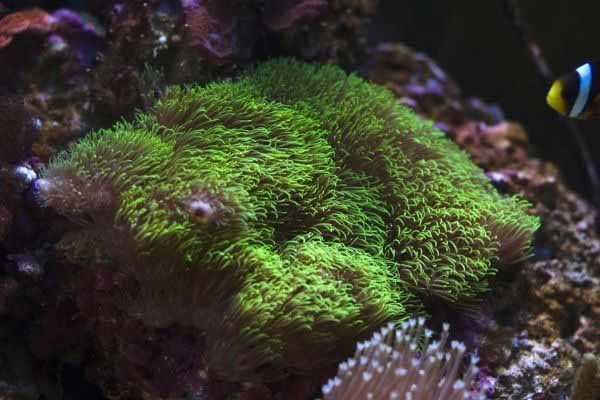
An alternate to GSP, if that isn’t your ideal beginner coral, is the Clove Polyp coral. You can learn more here.
Kenyan Tree Coral
You’ll also see the Kenya tree coral (Cladiella spp.), referred to as colt corals or cauliflower corals. The genus describes several different species of branching, tree-like corals. And while they appear delicate, you’re looking at soft corals for beginners. You have some leeway with their care needs, with lighting and flow ranging from moderate to high. The parameters you choose will determine how your coral looks, and your reef tank can end up vastly different in appearance from your friend’s.
Colt corals communicate with one another via chemicals. It makes them a unique addition to any beginner’s tank. Of course, they also utilize chemicals to attack other corals and even fish, defending their turf. If you’re new to managing corals and working with their sweeper tentacles, you’ll probably want to avoid adding any other species to your aquarium.
They grow very rapidly – sort of like the GSPs. Before you know it, your $5-$10 frag will have grown into a full “tree,” dropping branches (sending out tiny clones) to populate your entire tank.
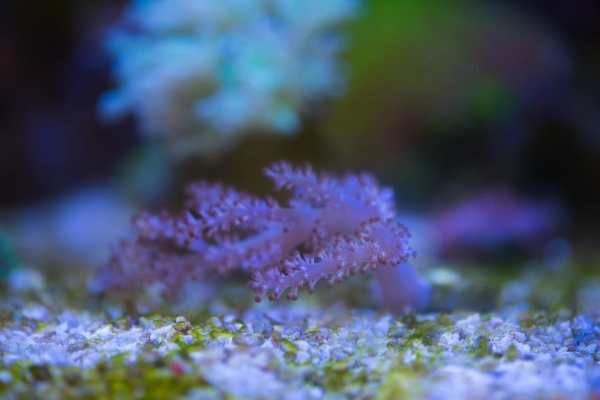
Mushroom Coral
When it comes to soft corals for beginners, it’s hard to get more bulletproof than mushroom corals (Discosoma spp. and Actinodiscus spp.). They’re the first coral I started out with, providing a sentimental preference. But you can’t go wrong with this decision, either. Believe it or not, mushrooms tolerate more dissolved particles in their water than most other coral species. It doesn’t give you a pass on leaving your water DIRTY, but it means you won’t need to run around, cleaning the tank every five minutes.
Some corals require high-intensity lights to keep their zooxanthellae happy. But mushrooms? They prefer the dimmer side of things. That saves you on setup costs. And you’ll know if you have your lighting correct based on whether or not the polyps stay open or curl up tight. Mushroom corals retract when they’re exposed to too much light. On the flip side, if they’re not getting ENOUGH light, you’ll see them stretch up and lose color. You can’t get better indicators when it comes to soft corals for beginners than that!
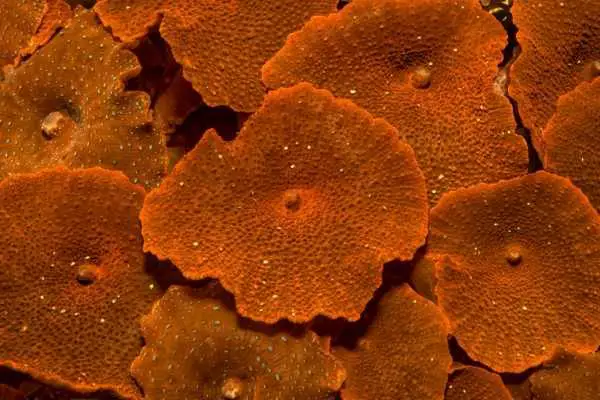
Toadstool Coral
Toadstool corals (Sacophyton spp.) are great soft corals for beginners. They are hardy and can grow quite large, becoming an impressive specimen over the years as your tank matures. You’ll see them start similar to the mushroom coral, but as they mature, they take on the folded appearance you see below. Inside, the tiny polyps stretch out, creating a beautiful display ANYONE would want in their aquarium. And since they don’t require more than moderate lighting and flow needs, pretty much anyone can handle them.
Of course, those spreading “umbrellas” mean you’ll need to think carefully about where you decide to place them. As they grow (and spread), they can end up blocking the light or nutrients from corals that end up beneath them. But that’s an important lesson for beginners. As you start to combine species together, placement becomes an important thought.
And toadstools will teach you patience. They’re known to close up AND shed. (Shedding soft corals? It’s true!) You don’t need to panic that you’ve done something wrong – a common fret when you’re dealing with soft corals for beginners. This is a natural process, and you’ll see the polyps open up within a few days.
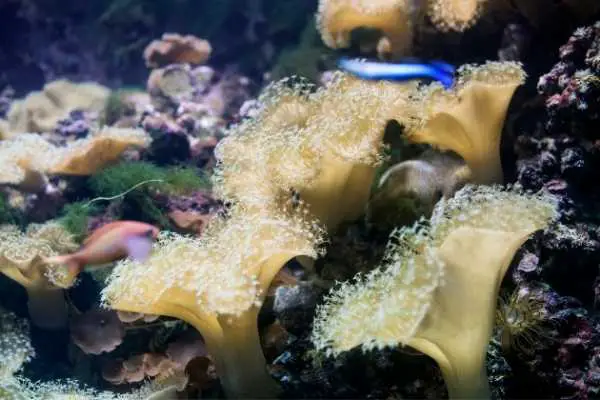
Zoanthids
Zoanthids (Zonathus spp.) – or zoas, as they’re usually called – are available in a mind-numbing array of color forms. You’ll find any psychedelic color combination you can imagine – assuming you have the cash to shell out for it. What makes them ideal soft corals for beginners? They handle and thrive in almost any lighting and water flow conditions. And since the zooxanthellae do the majority of the work, providing nutrients, you don’t even have to worry about spot feeding them.
You will need to take some care with your placement, though. The polyps within zoas contain a sting that allows them to “zap” other soft corals, and even small polyp stony (SPS) and large polyp stony (LPS) corals. They use sand, coral debris, and bits of rock to build their outer structure as they move. And they have NO problem with butting up against other corals they meet. It means you’ll want to look at your (empty) tank and think over placement carefully.

For More Information
Looking for soft corals for beginners – without dramatically increasing the complexity of keeping everything healthy and thriving? The five bulletproof species listed in this article are a great place to start. I’ve had a lot of success with each of them over the years and still have many of them thriving in my tank today.
But if you want to make sure you’re on to your game, you can watch this short YouTube video to learn what it takes to care for soft corals for beginners:
And if you want to dive deeper into the world of keeping corals and fish in a reef tank, there are a few places you should go next to dive deeper:
- Setting up a new reef tank
- Soft corals
- Want to know which books to add to your library? Check out the Reef aquarium book series
- Saltwater Aquarium 101 online course.
A few other great, hardy coral options
There are lots of great coral options you could add to your tank, you don’t have to limit your choices to these 5 beginner corals. You may also be interested in:
What has your experience been with these corals?
Please leave a comment below about your experiences with the corals listed above, or share a species you think would make the perfect soft coral for beginners!
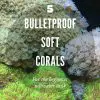
Leave a Reply